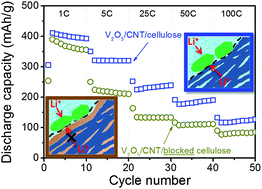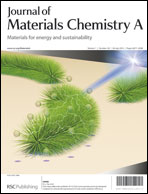Paper, a low-cost and flexible substrate made from cellulose fiber, is explored in this study as a platform for fast electrochemical energy storage devices. Conductivity and Li-storage capabilities are introduced to the paper by functionalization with carbon nanotubes (CNTs) and V2O5, respectively. The Li-storage paper cathodes present a remarkably high rate performance due to the high conductivity of CNTs, short Li+ diffusion length in V2O5 nanocrystals, and more importantly the hierarchical porosity in paper for Li+ transport. The specific capacity of V2O5 is as high as 410 mA h g−1 at 1 C rate, and retains 116 mA h g−1 at a high rate of 100 C in the voltage range of 4.0–2.1 V. To understand the role of mesoporosity in individual cellulose fibers, we created a control structure by intentionally blocking the mesopores in paper with a 20 nm Al2O3 coating applied via atomic layer deposition (ALD). We found that the V2O5 capacity decreases by about 30% at high rates of 5–100 C after blocking, which serves to be the first confirmative evidence of the critical role of mesoporosity in paper fibers for high-rate electrochemical devices.

You have access to this article
 Please wait while we load your content...
Something went wrong. Try again?
Please wait while we load your content...
Something went wrong. Try again?


 Please wait while we load your content...
Please wait while we load your content...